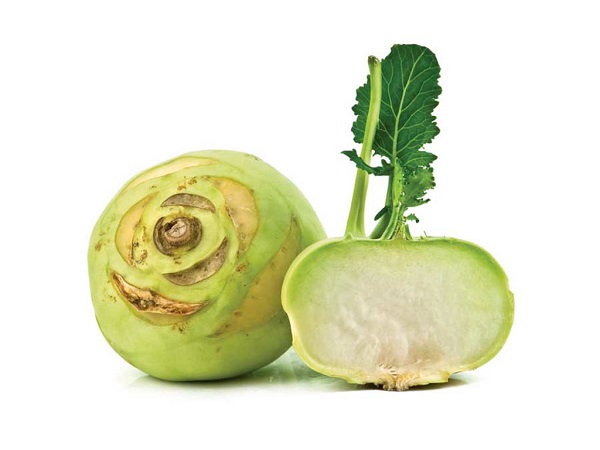Kohlrabi cabbage is particularly popular with modern gardeners. This happened due to the fact that the benefits from the use of this vegetable crop are much higher than from ordinary cabbage. In addition, this variety can grow even inexperienced summer resident.
Table of contents
What is kohlrabi?
Kohlrabi is a biennial food plant of the cruciferous family.Refers to the botanical variety of cabbage garden. The large leaves of the stemmer have a dark green color. The lower root part resembles a turnip. The color of the fruit depends on the variety, and may be light green and purple. This is a valuable diet product with a pleasant taste of cabbage stalk.
Historical facts
The first mention of kohlrabi dates back to 1554. Homeland plants consider the eastern Mediterranean. Later, cabbage appeared in Western Europe. Delivered to Russia from Germany, from German it is translated - cabbage turnips. The Italian name is consonant - calvole rapa.
Resistance to adverse environmental conditions was the determining factor in its spread throughout the world. Kohlrabi is grown in the Far East and the Far North of our country, in America, Canada, and Europe. It is popular in Asia - China, India.
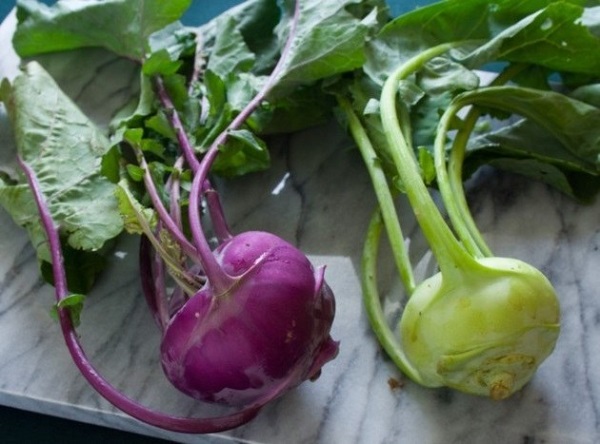
Useful properties of cabbage
The unique composition of kohlrabi is determined by a record number of trace elements and vitamins:
- Magnesium is needed to nourish the heart muscles and blood vessels;
- Phosphorus stimulates the blood circulation of the brain;
- Potassium regulates the water balance in the body, normalizes the muscles, nervous system;
- Selenium is an antioxidant, strengthens the body's defenses;
- Calcium is involved in blood formation, metabolism, it is necessary for teeth, nails, bones;
- Iron is responsible for the level of hemoglobin in the blood, prevents the occurrence of anemia, signs of fatigue;
- The vitamins of group B are considered to be a close-knit team of energy drinks, their deficiency entails extremely negative consequences;
- Vitamin E is a vitamin of youth and beauty;
- Vitamin C plays an important biological role in all body systems.
In addition, this vegetable culture is rich in mineral salts and enzymes. It includes vegetable proteins, fiber, glucose, fructose. Along with this, a low calorie content of 41.8 Kcal per 100 g explains the dietary value of cabbage. As part of kohlrabi tartronic acid is present, it breaks down carbohydrates, not allowing them to turn into fat.
Regular use of kohlrabi is recommended for such problems as:
- the appearance of edema;
- high cholesterol;
- constipation;
- pulmonary tuberculosis;
- diseases of the upper respiratory tract - asthma, bronchitis and others;
- Diseases of the gastrointestinal tract associated with low acidity of gastric juice.
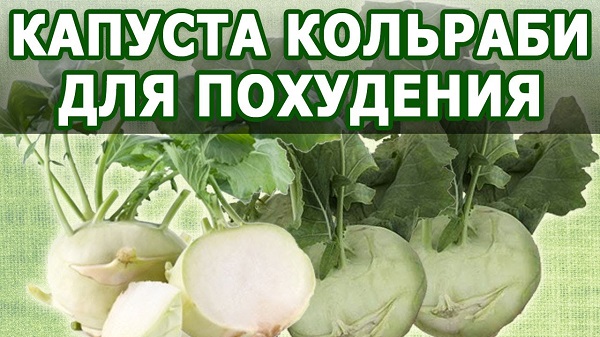
Growing from seed
The cultivation of kohlrabi is carried out by sowing seeds in open ground and seedling method. In the middle zone of the Russian Federation, the latter method is recommended for obtaining early harvest. Grow seedlings at home in boxes or in greenhouses.
Seed dates
Experts recommend three terms of sowing seeds. For early harvest, seeds are sown for seedlings in the second decade of March. Crop harvested in the first decade of June. For the harvest to ripen in late July, seeds are sown on seedlings in early May. The third term - at the end of June, sow seeds in open ground, harvest in early October.
Sowing seeds and caring for seedlings
To obtain high-quality seedlings are their preplant preparation.The first stage consists in heat treatment in hot water for 10–15 minutes, followed by immersion in cold water. The second stage is soaking the seeds overnight in a solution with trace elements. The third - after washing the seeds are placed in the refrigerator for 24 hours. You need to wait for the seeds to wrap in a damp cloth.
Further, individual containers or cassettes are filled with garden soil. Seeds are sown one per pot. This method eliminates the need for picking, which damages the root system of the seedlings. Crops are covered with a film. Temperature conditions should be within + 20-22 degrees. After the emergence of shoots, the film should be removed, and the temperature should be lowered to + 10 degrees. After 12-14 days, the temperature set + 16-20 degrees.
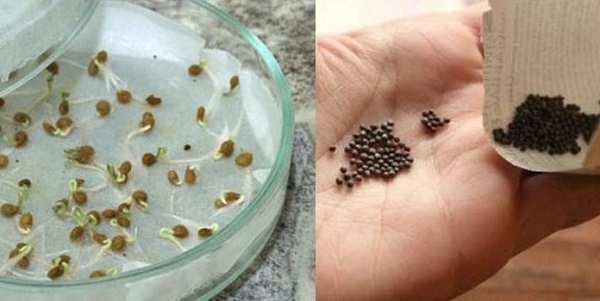
Caring for seedlings is in the following activities:
- maintain the necessary temperature in the room so that the seedlings do not stretch out;
- to carry out prophylaxis against the “black leg” with a pink solution of potassium permanganate;
- to feed plants in the phase of two leaves with microelements and complex mineral fertilizer.
Picking
A pick is needed if the seeds have been sown in a common container.Then it is necessary to plant the plants in the phase of one true leaf in peat pots.
For the disguised seedlings, the temperature is maintained at + 18 degrees during the day and + 10 at night. Hardening of the plants should be carried out several days before disembarking to a permanent place. Since the cold initiate the appearance of arrows, no need to rush to plant seedlings.
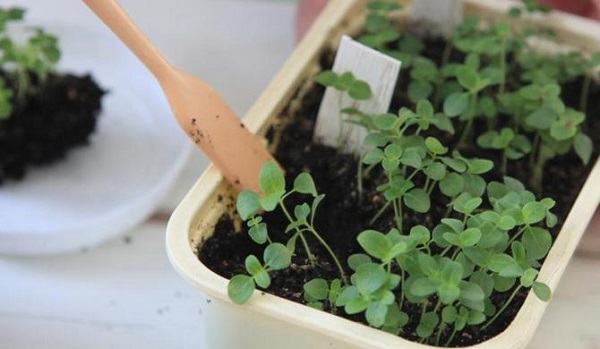
How and when to plant seedlings in open ground
For beds choose sunny areas. Culture can be grown as a compactor with other vegetables, herbs.
Soil for planting
Kohlrabi is not demanding on the composition of the soil, but hard fruits grow on acidic, non-fertilized beds. In the autumn, the site should be prepared for digging by adding organic matter, ash, urea and superphosphate.
The amount of fertilizer applied will depend on the composition of the soil. If necessary, lime is added. Early spring, the soil is dug up, loosened. When digging, ammonium nitrate is added at 15 g per 1 m2.
Landing rules and times
To work choose gloomy day or evening. Planting seedlings in open ground is possible when the plant has 5-6 leaves possible. To plant bushes need to respect the distance between the rows of 60 cm, between seedlings of 25 cm. The distance is adjusted depending on the variety. It may be somewhat less in early-ripening varieties. Most of the Kohlrabi varieties are early maturing, maturing 65 - 70 days. Late growing season has 120 days or more.
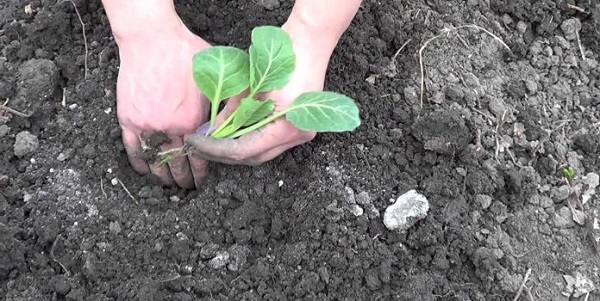
When planting seedlings can not be deeply buried in the ground because the formation of the stebleplod can be disturbed. After planting, the plants should be well watered and mulched.
In parallel, they are sowing seeds for seedlings of the second crop, it will need to be planted in the second decade of June.
In open ground, kohlrabi seeds can be sown in early May. To harvest the fresh fruits of cabbage was the whole season, the seeds are sown twice more with an interval of 20-30 days.
Sowing is made to a depth of 15-20 mm according to the 4 * 50 cm scheme. After the appearance of this leaf, it is necessary to thin the seedlings. Ultimately, the distance between plants should be at least 20 cm.
Care for kohlrabi in the open field
Fruits form when the plant has 7-8 leaves.They quickly gain mass. Care in the beds is the timely weeding, loosening between the rows and hilling stelplod.
During the growing season, it is necessary to carry out root feeding with complex fertilizer with trace elements twice. If necessary, do foliar spraying of a solution at the rate of 20 g of urea and potassium sulfate in a bucket of water.
Pest and disease protection
Cruciferous are prone to disease and are affected by pests. Kohlrabi suffers from them somewhat less, but can be affected by bacteriosis, kilo, powdery mildew, dry rot, mosaic, black leg. This will not happen if preventive measures are taken on time:
- observe agrotechnical rules of care;
- use tested and prepared seeds with warming and disinfection with special preparations or a solution of potassium permanganate;
- clean up and burn residues after harvesting with deep digging of the soil;
- systematically remove weeds;
- choose varieties resistant to diseases.
Insects, cabbage pests, quite a lot: cruciferous fleas, wireworm, moths, slugs, bear, cabbage bed, aphid and others.
Prevention is also important here. In addition to the above measures, one of the main ones is the implementation of the rule on crop rotation.
In the event of disease and insect damage, treatment of plants with fungicides and insecticides is necessary. Their range is wide enough in the modern market. However, the harm of chemicals is not questioned. It is best to comply with agricultural techniques and use harmless folk methods.
Harvesting and Storage
Kohlrabi cold-enough culture. For winter storage, it is removed in late September, early October, when the temperature begins to drop to zero degrees. Harvesting is carried out on a sunny day.
As is already known, three crops can be harvested for the garden season. The first two are harvested selectively, avoiding overgrowth of cabbage over 8 cm. With a larger diameter and weight of more than 100 g, it coarsens, loses its taste. The shelf life of 3 days under normal conditions, up to one month in the refrigerator.
In order to competently ensure the winter storage of cabbage, we recall the following rules:
- purple fruit colors are best suited for storage;
- root crops pull out, shake off the ground or wipe with a cloth, do not wash;
- the leaves are cut, leaving the tips of 15 mm;
- choose to store healthy, whole fruits;
- placed in a cellar in boxes sprinkled with sand.
The optimal storage conditions are to maintain a humidity of 95% and a temperature between 0 degrees and +5.
Many gardeners are biased to Kohlrabi, considering it overseas culture. However, when performing simple agrotechnical rules, this type of cabbage grows well in the Russian dacha. Due to its composition and beneficial properties, Kohlrabi will provide your family with essential vitamins and trace elements for the whole winter!
